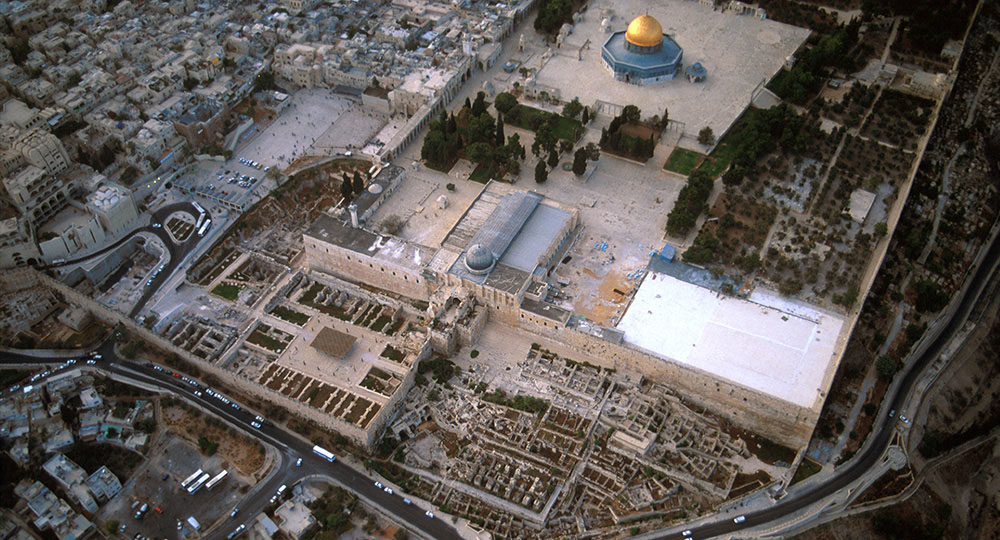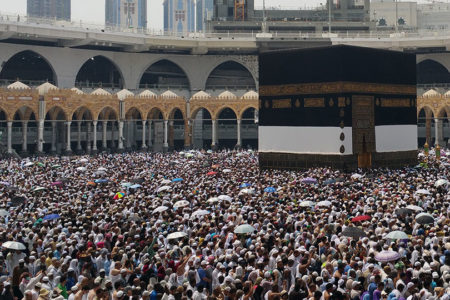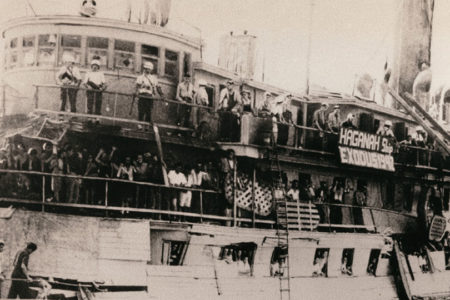Jerusalem in Prophecy
Jerusalem occupies a chosen place in the divine plan of the ages, being distinguished as such in the praise of the psalmist: “The Lord loves the gates of Zion more than all the dwellings of Jacob” (Ps. 87:2). It is this city alone to which God descended: “For the Lᴏʀᴅ has chosen Zion; He has desired it for His dwelling place: This is My resting place forever; here I will dwell, for I have desired it” (132:13–14).
Consequently, Jerusalem attained a status as both the holy city and the city at the center of the world (Ezek. 5:5). Given such a privileged position, it is no wonder Jerusalem is mentioned more than any other city in Scripture: more than 800 times (660 verses in the Old Testament and 142 in the New Testament) and appears in two-thirds of the books of the Old and almost half of the books of the New Testament.
While Jerusalem is the city’s most common appellation, it also has other names, such as Zion, Salem, and Ariel, and appears symbolically in allegory as “Hagar is Mount Sinai in Arabia” (Gal. 4:25) and in prophecy as “Sodom and Egypt” (Rev. 11:8). Of all biblical references, 465 in the Old Testament and 24 in the New refer to prophecies of Jerusalem subsequent to the time of their utterances.
In the Bible, Jerusalem occupies a strategic position with respect to two major prophetic periods: “the times of the Gentiles” (Lk. 21:24) and the “seventy weeks” of Daniel (Dan. 9:24–27).
In the case of “the times of the Gentiles,” the city prophetically marks the beginning and ending of this period that stretches from the Babylonian destruction (587 AD) until the Second Advent of Christ. In the case of the “seventy weeks,” events in Jerusalem determine the beginning and ending of this prophetic period and affect the parenthesis in time between the 69th and 70th weeks.
During the time of the first Temple, Jerusalem became the focal point of prophecy as foreign invaders sought to capture the holy city. On one such occasion, the prophet Isaiah prophesied Jerusalem’s deliverance while declaring God’s covenantal pledge to preserve the city for the future: “For I will defend this city, to save it for My own sake and for My servant David’s sake” (2 Ki. 19:34).
Jerusalem is at the heart of Messianic prophecy and redemptive history. In fact, it may be said that there could have been no such plan revealed apart from its presence (Lk. 13:33).
Jerusalem was indispensable to the preparation of Christ’s First Coming, being restored from ruin (Isa. 52:7–12) to fulfill its role in the Messianic advent as the city of the great King. Indeed, Jesus was sent to Jerusalem (Mt. 23:37), and the city served to mark defining moments in Jesus’ earthly life and ministry:
- Dedication (Lk. 2:22–38)
- Dialogue with teachers in the Temple (2:41–49)
- Temptation by the Devil (4:9–12)
- Confrontation with the moneychangers (Mt. 21:12–27)
- Signs of Messiahship (Jn. 5:19; 7:14–29; 8:2–12)
- Trial and crucifixion (Mt. 26––27)
- Resurrection and ascension (Lk. 24:1–51; Acts 1:9–11).
Following this pattern and Jesus’ command that the witness to the nations begin in Jerusalem, the church began in the city (Acts 2:1–13), the apostles performed miracles there (chap. 3), the Jerusalem Council met there (15:2–29), and from there Paul began his climactic trip to Damascus (9:1–6) and later experienced the conflict that lead to his imprisonment and death (21:27ff).
Jerusalem’s destruction in AD 70 by the Roman 10th Legion was predicted as the result of its rejection of Jesus and its persecution of the church: “And they will not leave in you one stone upon another, because you did not know the time of your visitation” (Lk. 19:44).
Yet Jesus’ prediction included the future hope of Jerusalem’s restoration when it repents and receives Him as Messiah (Mt. 23:39; Acts 3:19–21) at the Second Advent. Jesus even revealed the duration of its desolation, being “trampled by Gentiles until the times of the Gentiles are fulfilled” (Lk.21:24). Thus Jerusalem’s experience as the time of the end approaches is to be one of escalating tribulation until the seven-year Tribulation period arrives and the city finally finds deliverance at Christ’s coming (Mt. 24:21–31).
Daniel’s prophecy of the 70th week (Dan. 9:27) informs Jesus’ prophetic discourse on the Mount of Olives (Mt. 24; Mk. 13; Lk. 21), the apostle Paul’s prophetic instruction to the Thessalonians (2 Th. 2:4), and the apostle John’s prophetic vision of the city’s invasion by the nations (Rev. 11:1–2). According to Daniel’s prophecy, the Antichrist’s armies will occupy the city (cf. Dan. 11:45); desecrate the Temple; and usurp God’s place within it, demanding worship from the world (cf. Rev. 13:6, 15).
Zechariah’s prophecy prominently chronicles this period of distress for the city, detailing the gathering of all nations against Jerusalem (Zech. 12:2–3; 14:2) and the city’s battles until the climax of the campaign of Armageddon, when the final assault on Jerusalem takes place (chaps. 12—14).
The Lord will bring about Israel’s national repentance beginning with “the inhabitants of Jerusalem” (12:8—13:2). Christ will defeat the Antichrist’s invading armies (14:3, 12–15); deliver the Jewish remnant in the city by an earthquake (14:3–4); and there set up His Millennial Kingdom (14:9), transforming the city’s topography (14:8, 10), rebuilding the Temple (6:12–15), purifying and glorifying the city (8:3; 14:11, 20–21; cf. Isa. 4:5–6; Jer. 3:17), and calling the nations to worship Him (Zech. 14:16–19).
Isaiah, likewise, prophesied concerning Jerusalem in the Millennial Kingdom, declaring the elevation of the Temple Mount and its new position as the worship center for the world (Isa. 2:2–3) and center of the Messiah’s rule over the nations as He establishes universal peace (v. 4).
Isaiah also reveals the glorious reversal of Jerusalem’s fortunes in the Millennial restoration, announcing the predicted fulfillment for the city with the divine declaration, “For behold, I create Jerusalem as a rejoicing, and her people a joy. I will rejoice in Jerusalem, and joy in My people” (65:18–19).
Jerusalem’s restoration includes a restoration of harmony in the created order to prevent the defiling of “[God’s] holy mountain” in Jerusalem (11:6–9; 65:25). The nations will turn to Christ, becoming His people (11:10, 12; 19:25) and beholding His glory in Jerusalem (66:18–20).
The prophet Ezekiel focused on Jerusalem’s Millennial Temple and the city’s extended sacred status (Ezek. 40—48), depicting the Lord’s return to dwell in Jerusalem (43:1–7; cf. 37:26–28) and conferring upon it a new, descriptive title: “THE LORD IS THERE [Hebrew, YHWH Shammah]” (Ezek. 48:35).
The final assault on the city is predicted to occur at the conclusion of Christ’s 1,000-year reign when Satan, released from his imprisonment, deceives the nations and gathers an army to march against King Messiah enthroned in Jerusalem (Rev. 20:7–9). As He had promised (2 Ki. 19:34), the Lord defends Jerusalem and destroys these last adversaries of His holy city (Rev. 20:9).
With the creation of the new heavens and new Earth for the eternal state, apparently an earthly Jerusalem will continue in relationship to the heavenly Jerusalem in fulfillment of its divine destiny as the place where God’s name will remain forever (2 Chr. 33:4; cf. Ps. 48:8; 68:16; 132:14; Joel 3:20; Mic. 4:7).
In light of the position Jerusalem holds in God’s prophetic program and that the world’s hopes rest on His program’s fulfillment, let us heed the command of the psalmist to “pray for the peace of Jerusalem” (Ps. 122:6).








